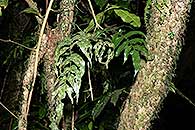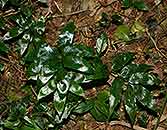Asplenium ceii Pic.Serm.
Synonyms |
Asplenium atroviride Schelpe |
|---|---|
Common name |
|
Description |
Rhizome erect, c. 1 cm thick; rhizome scales greyish-brown, lanceolate in outline, subentire, up to 10x 1.5 mm, apex gradually tapering into a hair-like tip. Fronds tufted, erect, not proliferous, herbaceous to coriaceous. Stipe matt-grey-green to brown, subglabrous, up to 50 cm × 0.3 cm. Lamina 18-40 x 10-19 cm, dark shiny green, pinnate, oblong in outline, basal pinnae not reduced, 2-6 (-9) pairs of pinnae plus a terminal pinna similar to the other pinnae but slightly longer and wider. Pinnae 8-14 x 1.8-2.5 cm, hairless, petiolulate, lanceolate-oblong in outline, margins shallowly toothed, base unequally cuneate, apex gradually tapering to a point. Rhachis subglabrous with scatered fimbriate scales when young. Sori linear, set along the veins at 50 degrees to the costa, (4-)9-13 mm long; indusium entire, membranous, 0.5-0.8 mm wide. |
Notes | Differs from similar species by not proliferous fronds and having only 2-6(-9) pairs pinnae. |
Derivation | |
Habitat | Deep shade on forest floor away from water in moist evergreen forest. |
Distribution worldwide | See African distribution. |
Distribution in Africa |
Burundi, Ethiopia, Kenya, Malawi, Mozambique, Rwanda, Sudan and South Sudan, Tanzania , Uganda, Zimbabwe. |
Growth form |
Epiphytic, lithophytic, terrestrial. |
Literature |
|




